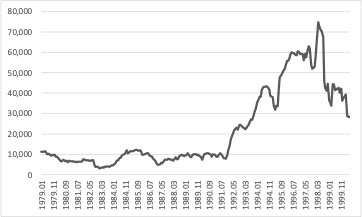Original thoughts The 30 year anniversary of the stabilization plan that controlled high inflation in Brazil, the so-called Real Plan, just passed earlier in July. I wanted to write something about it, but it got buried with other things. Here just some very short reflections. There was a huge coverage in the media and several new books and papers written about it, including by several of the actual participants of the stabilization plan. If I have to leave one impression beyond the problems of all the mythology making, and the self-congratulatory mood of the whole thing, is that most of the analysts, including the economists that designed the plan, unlearned what they knew back then. People start defending some ideas because they are convenient, and next thing they end up believing
Topics:
Matias Vernengo considers the following as important: Arida, Austral, Brazil, Cardoso, Cruzado, Edmar Bacha, Fishlow, Gustavo Franco, Heterodox Shock, Lara-Resende, Pedro Malan, Real
This could be interesting, too:
Matias Vernengo writes The behavior of the nominal exchange rate between the Brazilian Real and the dollar in 2024
Matias Vernengo writes Serrano, Summa and Marins on Inflation, and Monetary Policy
Matias Vernengo writes Very brief note on the Brazilian real and the fiscal package
Matias Vernengo writes Brief note on public debt and interest rates in Brazil
The 30 year anniversary of the stabilization plan that controlled high inflation in Brazil, the so-called Real Plan, just passed earlier in July. I wanted to write something about it, but it got buried with other things. Here just some very short reflections.
"Inflation is the result of a long process of fiscal disorder, that mirrors social demands and political conflicts, that cannot be resolved by the established institutional channels" (my translation).
In other words, inflation is caused by too much social spending and fiscal imbalances. The conflict is not, apparently one about income distribution, in the face of an external problem (foreign debt back in the 1980s). There is no mention of the exchange rate, the external obligations or the amount of reserves held by the central bank necessary to service the foreign debt.
Of course what allowed for the stabilization was the change in capital flows in the 1990s, in part the result of the lower rates in the United States after the financial crash of 1987, and more so after the 1991 recession, together with the Brady renegotiation of the external debt, that Brazil signed in 1992. By 1994 the reserves were reasonably large as can be seen below.
Reserves were very low in the 1980s, and that was the main reason for the failure of the heterodox plans, not just in Brazil, but in many other countries like Argentina. In May 1993, when Fernando Henrique Cardoso became Finance Minister, reserves were at about US$ 23 billion, and by the time the real became the currency, and the exchange rate between the real and the dollar was stabilized, reserves had more or less doubled (one can see the erosion of them after the 1999 crisis, and all of that is dwarfed by the accumulation of reserves that started in the second Lula government). There is a brief comment on the round-table at the Catholic University in which someone said that Gustavo Franco was instrumental in trying to keep the exchange rate stable, but it is almost an after thought.This is lack of understanding of what allowed for stabilization in the 1990s, and not in the 1980s (in the case of Israel the US provided a large transfer of reserves to their central bank; stabilization by invitation, one might call it), is generalized. Many papers trying to find some specific element of the stabilization plans miss the fact that everybody stabilized in the 1990s, once dollars started flowing to the periphery.



